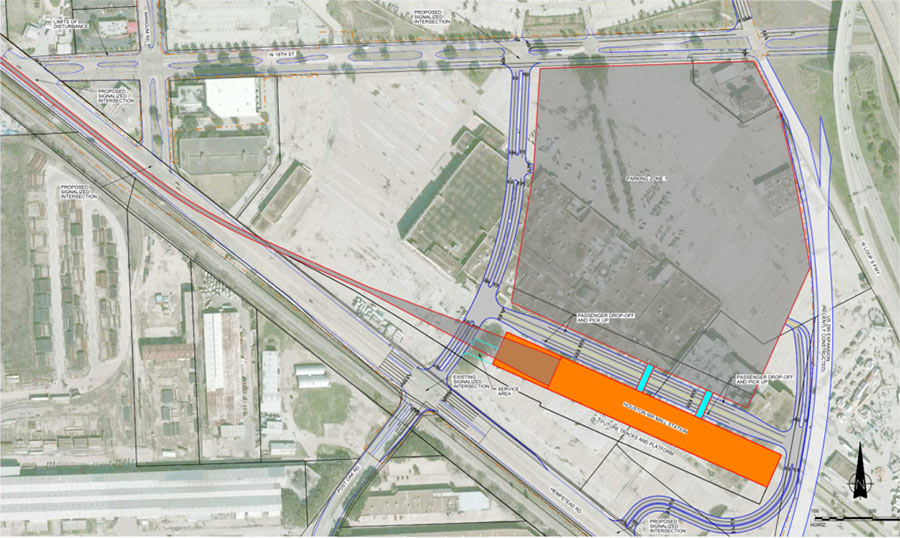
The video at top put out by Texas Central pans around the what’s now the Northwest Mall and its parking lot to show a new double-arched bullet train station and parking garage replacing them in the crotch where W. 18th St. and Hempstead Rd. meet the West Loop. Texas Central chose the 45-acre site over 2 others it was considering just south of the mall for the Houston terminus of the planned Houston—Dallas rail line. The terminal building — coded orange in the site plan above — sits between Hempstead and a new road that’s proposed just north of it. The parking garage would be located inside the gray zone indicated between W. 18th and the new street.
Elevated train tracks enter the station after crossing over a new extended segment of Post Oak Rd. Looking southeast from W. 18th St., one of Texas Central’s conceptual renderings of the site shows the tracks tracks heading into the terminal, next to the parking garage:
***
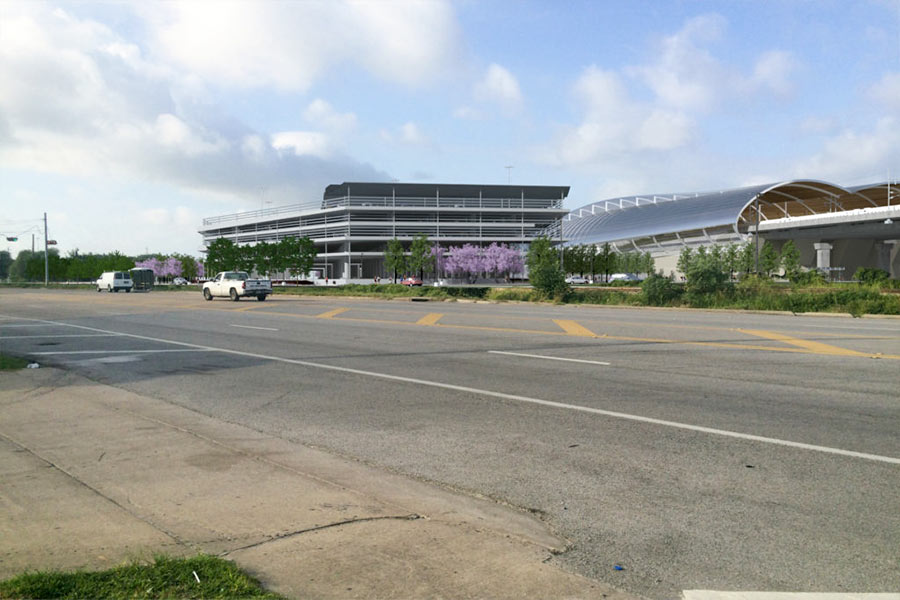
The traffic light those cars are gunning for on the far left marks a new intersection where Post Oak would end at W. 18th after cutting through what’s now the mall. Here’s the view looking south down Post Oak from that spot:
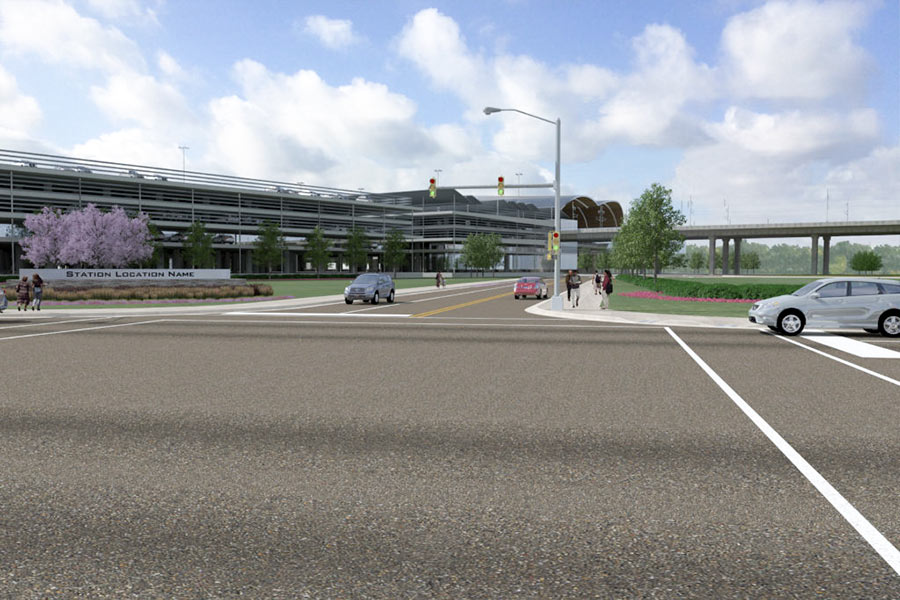
Just north of where the road runs underneath the tracks on its way to Hempstead, another imagined street branches off it and travels east toward the West Loop, between the station (off camera on the right) and the garage:
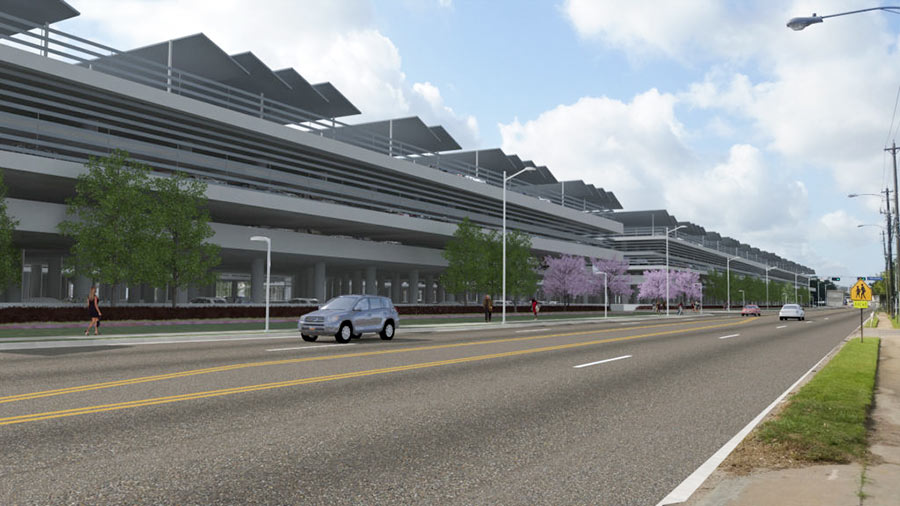
Amenities planned for the terminal — viewed below from its backside along the West Loop’s southbound feeder — include restaurants, bars, fast food, concessions stands, newsstands, and seating areas:
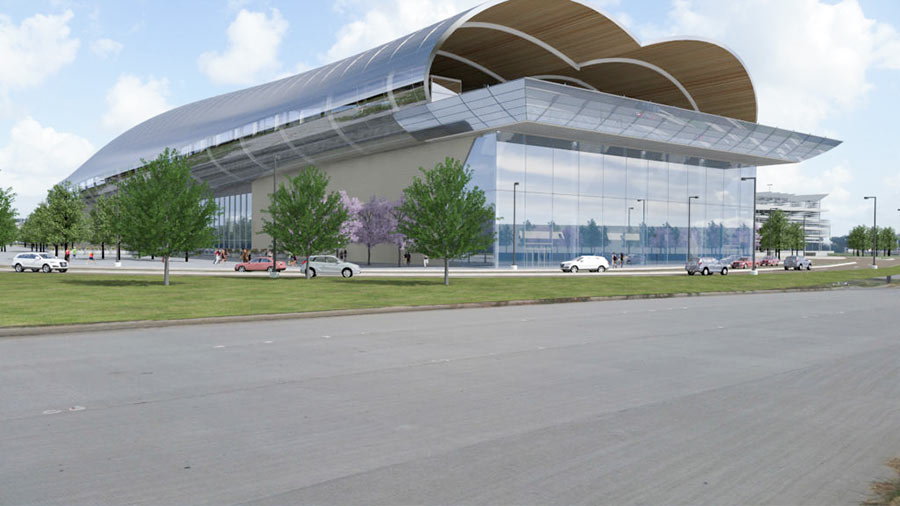
A closer view shows what appears to be an outdoor park behind the structure:
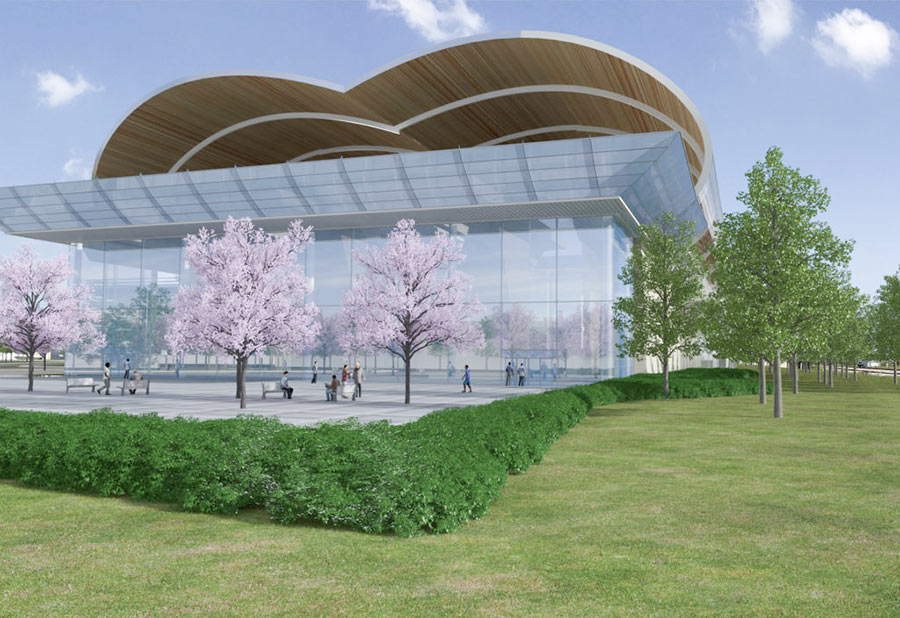
Here’s the southern boundary of the new rail complex at Hempstead where the train tracks cross over the street on their way into the station building:
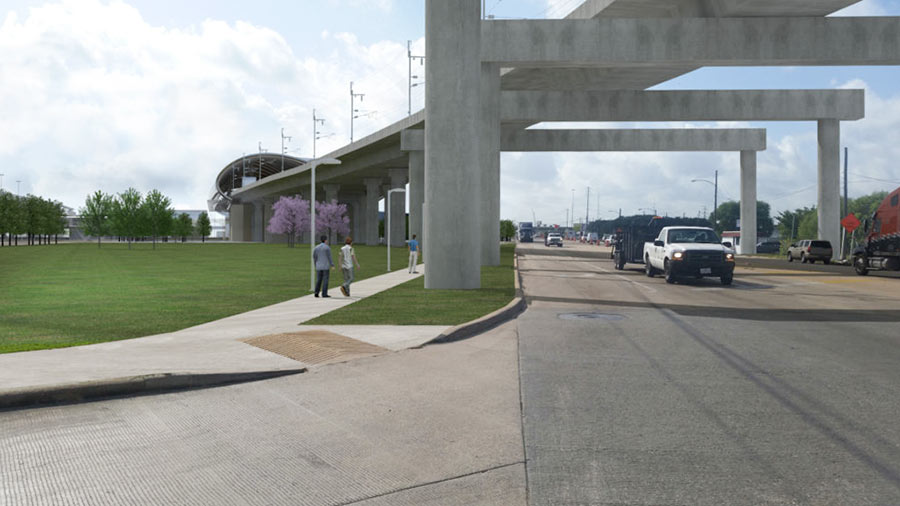
A representative who handles land acquisition for Texas Central tells the Chronicle’s Dug Begley the company is thinking about buying the parcel where the mall sits now. Public hearings have been ongoing in regions along train’s planned 240-mile route, and the Federal Railroad Administration is accepting comments through March 9 on the report it released last last December detailing where the tracks would run.
- Texas Central Announces Its Houston Bullet Train Station Preferred Location [Texas Central]
- Northwest Mall tapped as site of southern terminal for Houston-Dallas bullet train [Houston Chronicle]
- Previously on Swamplot: The 3 Finalists for Houston’s High-Speed Rail Station: Northwest Mall, Northwest Transit Center, Hempstead Rd. Industrial; The Ride to the Bullet Train at Northwest Mall;Â Houston-to-Dallas Bullet Train Putting the Brakes on All Those Lawsuits;Â Houston-Dallas Bullet Train Shows Up on Trump Infrastructure Project List;Â Possible Station Locations for Houston-to-Dallas High-Speed Rail: Jersey Village, Mangum Manor, Downtown?
Video and Renderings: Texas Central





Are people still under delusion that this will happen? The main characters in this story are merely spending tons of investor money on publicity and dog and pony show with hopes to raise more money and eventually run off with as much of it as they can when the project will be “deemed unfeasible in current market climate†or some other such excuse.
@commonsense: say what?
By the time this would be built and in operations (15 Years), we should have driver less cars. $20 Billion on Light Rail or $10 Billion on Flood Improvements for Houston.
commonsense is right. highspeed boondoggle isn’t happening. The estimated $15 billion price tag (up from initial $10-12 billion) already is completely infeasible.
What about the environmental concerns, I feel that the grand parkway has lead to a lot of the flooding in Houston. A Bullet train is going to have far more impact, on much more than flooding and traffic. I think I read they raised $115M of the whatever Billions they need.
I have to say Common’s theory still has legs but I would be shocked if this happened so publicly. What kind of record do the major players have with this kind of thing?
If this thing doesn’t have a train going to downtown, it will fail. How is the west loop a destination?
There is no finanical solvent way to get the rail downtown. Politicians and the NMBY would never allow it to go through the neighborhoods to downtown. It is just not financially feasible.
The city of Houston is developing out that direction, plus if you look at a map will see the station is not that many miles from downtown. And the Galleria is just south of the location. Metro is currently building a BRT line up Post Oak towards the Station. And once the station is built, it might finally pressure Metro and the City to build the inner Katy light rail line they have previously planned. The Station could be the boost the city needs to get more mass transit projects done.
Anyone who uses the word “boondoggle” non-ironically reveals a lot more about themselves than about whatever project they have in question.
when you spend $17 billion on a HSR train you have to budget whatever it takes for property aquisition or build a tunnel to the CBD. this will come back to haunt the city. City leaders dropped the ball on this one
Having the rail stop in CBD makes sense for business travelers, but for everyone else it will be a challenge to find parking. Many of the parking lots downtown do not allow overnight parking. Out at the NW mall, you could provide overnight parking for a fraction of the cost of downtown. Also, in the future, you could set up an extension of light rail to NW mall from downtown along Washington Ave.
Extremely pisspoor location. Makes zero sense to place such a large, expensive project such as this so far from the main central business district. And don’t give me the excuse that this location is more central to Houston’s mostly skewed western population. Most of Dallas’ population is heavier to its North and yet they’ve managed to keep the proposed station in their downtown area.
Care to refute the statement or too infatuated with the word boondoggle TMR? Here’s a little bit of info for you https://en.m.wikipedia.org/wiki/Boondoggle. Next time you want to infer something about someone as being a reflection of there word choice you might want to be up to par with the vernacular.
Turning_basin – you never provided any evidence or argument yourself. It’s nothing but a stubborn “I don’t like it”, probably on purely cultural aesthetic grounds.
@TMR – Boondoggle implies a project which begins to snowball with non-forecasted costs. I would say jumping 3-5 billion dollars from initial projected costs, which I state in my initial comment, before you ever even start, qualifies. Which is the evidence and the argument. You should “probably” save your brash “quoted” generalizations for someone else.
Cougarpad is right, this location is better than downtown b/c it does force Metro Rail’s hand in getting connections down Washington Ave towards downtown and Post Oak towards Galleria area. Once those connections are made, the Katy & Cypress areas have their own target to a much easier NW Mall location to connect. It helps so much more than just getting HSR to downtown with no other connections. Dallas residents are the ones crying about the train not getting to downtown Houston b/c hey don’t care about our city. People from Houston, that want to see the best for their city, should not be in favor of this going straight into downtown.
This location was the only one that made sense to me. As much as you would think it should go straight to downtown, that isn’t where everyone who will be using this train wants to go or travel from. Houston has business districts all over the place. Not everyone goes downtown. From that location you will be able to eventually hop on BRT to the Galleria, you have the 610 loop and I-10 right there to take you whichever way you want, and you got the Metro buses all right there. It’s an ideal location.
I think everyone who hears about this project thinks it’s purely catering to business travelers and it’s not. There will be a lot of “regular” folks using this service for sure. I know I will.
People need to get over having this go to downtown. This rail station needs to be conceptually though of as not different than an airport. Many of the users will Taxi, Uber, park in the garage.
Add that Uptown, Westchase, Memorial City, and Energy Corridor skew dense employment centers to the west. This is a more central location.
No, it needs to go Downtown because of the Convention Center and the crucial mass of office workers. In Dallas the terminus is next to the Convention Center. Houston won’t have that. That is a disadvantage. Instead you have HISD HQ and Awty school, wow! Plus, it is a boondoggle and will basically ruin the area between Waller and 99 along 290(as well as Hempstead Road). That area has much more future taxable value potential and the potential to create good jobs than a large parking garage with maintenance facilities attached to a Fudruckers and a Lubys and a Starbucks.
Site plans of both stations (Houston and Dallas) makes it clear that the revenue model for this project isn’t selling train tickets; it’s selling parking. This site is ideal for that purpose: no where nearby (walking distance) to compete for parking revenue, and much cheaper land cost than downtown.
If you’re going to make the station 80% parking garage, why bother spending the extra money running it all the way to downtown?
Hey everybody, just a reminder. This would be a privately-funded project. Texans really shouldn’t complain about investments in pipelines or refineries that cost tens of billions of dollars because the investors might ultimately lose their money; we go to work building them, we earn money, we invest our money elsewhere, and when we are done we levy property taxes on them.
.
Many of Texas’ railroad companies have gone bankrupt in the past, but that doesn’t mean that even the railroads that went bust weren’t beneficial to the state’s economic development. If it happens to TCR (and I’m not saying it won’t), this is not uncharted territory. Equity gets wiped out, bondholders take a haircut, and/or the assets are sold to a new owner. In the very worst of cases, when operating revenues cannot cover operating costs, then railroads get abandoned. Let’s say that that happens here. The public sector, which would’ve already reaped the fiscal benefits from construction, has two options: 1) do nothing, which costs nothing, and which is ordinarily what is done to abandoned railroads, or 2) cover the difference in order to maintain operations.
.
Why would the public sector cover the difference? Well, obviously because doing nothing is worse than doing something. If doing nothing means that there is more traffic on I-45 and that it needs to be widened to six lanes all the way between Houston and Dallas, that would be really damned expensive. If doing nothing means that air service is crowded out by Houston-Dallas flights, then that represents an opportunity cost to serve other destinations. It shouldn’t be beyond the realm of reason, but if that ends up being the case then really it is the private sector that has accidentally subsidized the public sector by providing it with lower-cost options for handling inter-city mobility rather than the other way around.
@Turning_basin that happens to practically every project.
All “boondoggle” means is that you personally don’t like the project, and usually for cultural aesthetic reasons. Red-staters think rail projects are boondoggles and freeways necessary transportation enhancements, and blue-staters tend to think vice versa. The use of the word non-ironically implies that the user hasn’t thought about these things all that deeply.
It’s private money, why not let them build it if they think they can make it work. A private company is not going to give COH billions for light rail or flood control, so I think a lot of people on this post are confusing the point here of public money vs private money. You either accept that a company wants to spend that kind of money in the region, or tell them to go somewhere else because we don’t like the concept. Now if the city says they won’t pay taxes for the next 20 years that a different story, but the in the press conference they didn’t say that…instead they said we would tax them. I don’t also understand why people think the city will take it over when or if it fails. You don’t see the government taking over private airports when they fail and keeping them running.
This is only the PREFERRED location. FRA says that all 3 Houston locations are still in play.
—–
From the DEIS:
“While FRA is identifying a preferred alternative in this Draft EIS, FRA will continue to analyze all Build
Alternatives and Houston station options through the Final EIS. Focused analysis on the preferred
alternative and Houston station options will be completed in coordination with federal agencies to
support permit applications, biological opinions and Section 106 consultation.”
Also TCR will seek federal loans and local tax breaks. If they get billions from the federal government and fail, that is taxpayer money.
And the project will require over 100 miles of new roads, which TCR will generously gift to counties to maintain, including new overpasses.
If it fails, it won’t be like an empty Walmart, it will be a big ugly wall cutting people’s land in two.
@ Jules: The TCR tracks and rolling stock would all be taxable property. If you go by TXDoT’s estimate of the cost, at $18.3 billion, for 240 miles of track, that’s an average of $76.25 million per mile. TCR would traverse 10 counties, so the average county would capture a $1.83 billion tax base. No exemptions. For some of these counties, that is more than their total existing tax base. Even if the value gets significantly written down in the future, yeah I think that the counties will be able to afford maintenance on some overpasses.
Niche, thanks. They do say they will pay 2.5 billion in taxes from now until 2040 in state, county, local municipalities, schools, hosp districts, and community colleges. Does that sound right to you from your numbers?
.
And what if they went bankrupt?
Maybe I am missing something important and/or I am being overly naive here, but why are the NW and DT locations mutually exclusive? Wouldn’t it actually be feasible to have both? A NW station with lots of parking space to serve the Galleria and all of the western suburbs, and a much smaller station downtown serving business travelers, and sports- and convention- goers (as well as indirectly making the eastern-half of the city less isolated)?
@Southerncrj: It’s about speed. They have stated they want the trains to run from Houston to Dallas in 90 minutes. That’s how they compete with air travel. If you start downtown, then stop 5 miles away at NW Mall, then start up again, you’re building extra travel time into the system. Plus when HSR travels through urban environments, it’s speed is limited as a safety measure.
Look at JR East’s main shinkansen ( bullet train) line from Tokyo to Osaka. After leaving Tokyo Station southbound, it travels at maybe 60 mph for the first 10 or so miles until it’s in a less dense area then speeds up. There is a big city called Yokohama maybe 30 miles south of Tokyo with a population in the millions. The station there 9 Shin-Yokohama) is on the outskirts of the city so the train doesn’t have to slow down as much, and probably ROW costs. People in Yokohama deal with it, and don’t complain that the station isn’t downtown. It works.
Shady, I’m curious how you know what people in Yokohama do and don’t complain about.
.
The noise is one factor for the slow speeds. The faster they go, the louder they are.
@ Jules: If TCR goes bankrupt then its equity investors lose everything, its bondholders either become owners or sell the asset, and if operating revenues exceed operating costs then the service continues to operate. The same thing has happened to numerous railroads throughout Texas’ history, and it also happened to State Highway 130 in the Austin area.
.
If the asset is utterly incapable of generating an operating profit under any circumstances — an improbable but not impossible circumstance — then all operations cease. However, even abandoned railroads have a taxable value. If the owner cannot pay their taxes, it will be sold at a tax auction to the highest bidder. At that point it is basically just a ROW. But ROWs are valuable. It might be used in the future for electric transmission, pipelines, freight rail, a toll road, or some kind of reincarnated people-moving infrastructure such as hyperloop. In any case, even as abandoned ROW, the land will be much more valuable than ag-exempt or wildlife-exempt land. It’s my opinion that the potentially very large rewards justify the relatively minimal risks.
The tracks won’t support freight but nice try
pig in a poke blowin smoke maybe they can turn the lot behind it into a mini dinosaur them park.
Hey Shady, thanks for replying. I have to say I actually disagree with you. I have traveled in the very train you mention, and to an extent it was one of the motivations for my comment. For those for whom the NW station is most convenient, the trip would stick to the stated ~90 mins. I do not think that the extra ~10-15 mins that it would take the train reach DT would be a deal-breaker for the DT-centered demand. In fact, that’s less than the time that it would take them to reach DT from the NW station by car. I do not think time is the main issue here, but rather that the problem is likely financial, and that somehow adding a DT station would be too expensive (which I do find surprising and disappointing, but plausible).